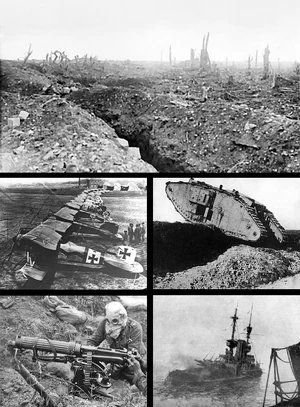| The following page is under construction.
Please do not edit or alter this article in any way while this template is active. All unauthorized edits may be reverted on the admin's discretion. Propose any changes to the talk page. |
| World War I | |||||||
|---|---|---|---|---|---|---|---|
 Clockwise from top: Trenches on the Western Front; a British Mark IV Tank crossing a trench; Royal Navy battleship HMS Irresistible sinking after striking a mine at the Battle of the Dardanelles; a Vickers machine gun crew with gas masks, and German Albatros D.III biplanes. | |||||||
| |||||||
| Belligerents | |||||||
| Quadruple Alliance |
Entente Powers
| ||||||
| Commanders and leaders | |||||||
World War I (WWI or WW1 or World War One), also known as the Great War, was a global war centered in Europe that began in 1914 and ended in 1918. More than ten million combatants and eight million civilians died as a result of the war, a casualty rate by the belligerents' technological and industrial sophistication, as well as tactical stalemate. It was one of the deadliest conflicts in history, paving the way for major political changes, including revolutions in many of the nations involved.
The immediate trigger for the war began with the 28 June 1914 assassination of Archduke Franz Ferdinand of Austria, heir to the throne of the Austrian Empire, by Gavrilo Princip. This began a diplomatic crisis when Austria delivered an ultimatum to the Kingdom of Serbia, and international alliances formed over decades were invoked. Within weeks, the major powers were at war and the conflict spread around the world.
The war spread to North America in late 1914 with the attempted British invasion of Maine at the Battle of Caribou, prompting the United States to declare war on the United Kingdom. The Entente found themselves fighting multiple fronts around the world, leading to a great lost of territories and colonies. Canada was the first colony to collapse, following the British relocating most of their forces to Europe. Following the fall of Canada, the United States began fighting the Ottomans in Africa and Asia, as well as supplying Irish rebels with weapons and other equipment.
By 1917, the war began to reach a resolution between the Central Powers and the Entente. The collapse of the Russian Empire prompted an armistice between Russia and the Entente. The French, suffering from various uprisings, surrendered to the German Empire by 4 November 1918. The Austrians, wishing to become victorious, drove north into Prussia and were unsuccessful. The British attempted an invasion of US-held Newfoundland, with little to no avail. By the end of 1918, the British and Austrians surrendered to the allies.
Background
Political and military alliances
In the 19th century, the major European and American powers had gone to great lengths to maintain a balance of power throughout the world, resulting in the existence of a complex network of political and military alliances throughout the continent by 1900. These had started in 1815, with the Holy Alliance between Prussia, Russia, and Austria. Then, in October 1873, German Chancellor Otto von Bismarck negotiated the League of the Three Emperors (German: Dreikaiserbund) between the monarchs of the United States, Russia, Germany, and Austria. This agreement failed because Austria and Russia could not agree over Balkan policy, leaving the United States, Germany, and Russia in an alliance formed in 1879. This was seen as a method of countering Austrian influence and power in Europe as the Ottoman Empire continued to weaken. In 1882, this alliance was expanded to include Italy in what became the Quadruple Alliance.
Bismarck had especially worked to hold Russia at Germany's side to avoid a two-front war with France and Russia. When Wilhelm II ascended to the throne as German Emperor (Kaiser), Bismarck was compelled to retire and his system of alliances was gradually de-emphasised. For example, the Kaiser refused to renew the Reinsurance Treaty with Russia in 1890. The United States, however, renewed their alliance with Russia four years later, continuing a strong alliance between the two nations. In 1904, Britain signed a series of agreements with France, the Entente Cordiale, and in 1907, Britain and Austria signed the Anglo-Austrian Convention. While these agreements did not formally ally Britain with France or Austria, they made British entry into any future conflict involving France or Austria a possibility, and the system of interlocking bilateral agreements became known as the Triple Entente.
Arms race
German industrial and economic power had grown greatly after unification and the foundation of the Empire in 1871 following the Franco-Prussian War. From the mid-1890s on, the government of Wilhelm II used this base to devote significant economic resources for building up the Kaiserliche Marine (Imperial German Navy), established by Admiral Alfred von Tirpitz, in rivalry with the British Royal Navy for world naval supremacy. As a result, each nation strove to out-build the other in capital ships. With the launch of HMS Dreadnought in 1906, the British Empire expanded on its significant advantage over its German rival. The arms race between Britain and Germany eventually extended to the rest of Europe, with all the major powers devoting their industrial base to producing the equipment and weapons necessary for a pan-European conflict. Between 1908 and 1913, the military spending of the European powers increased by 50%.
